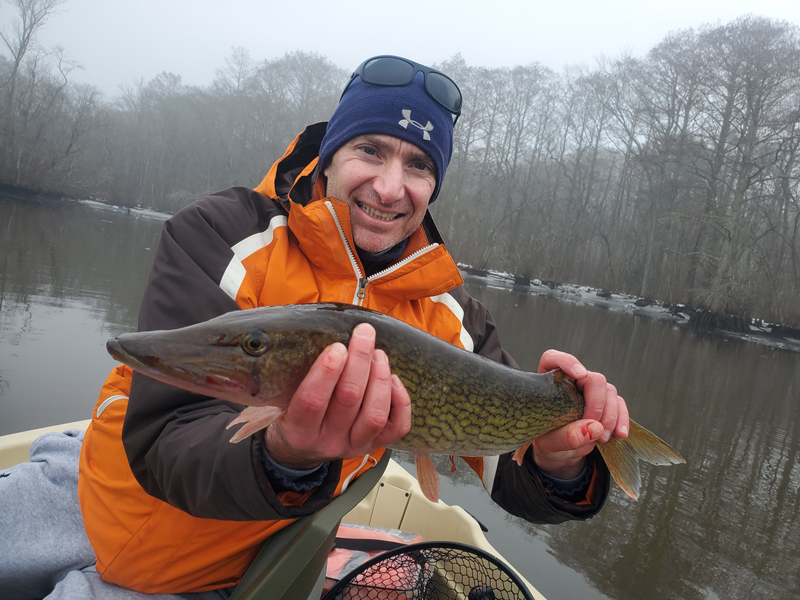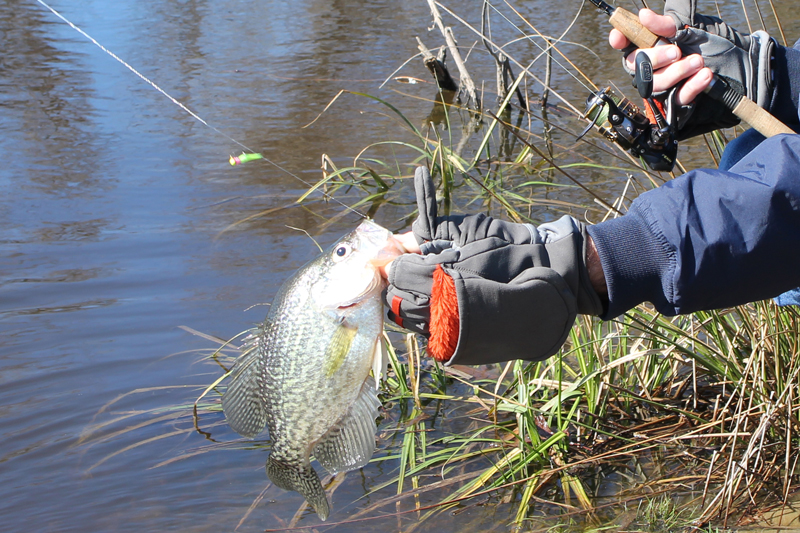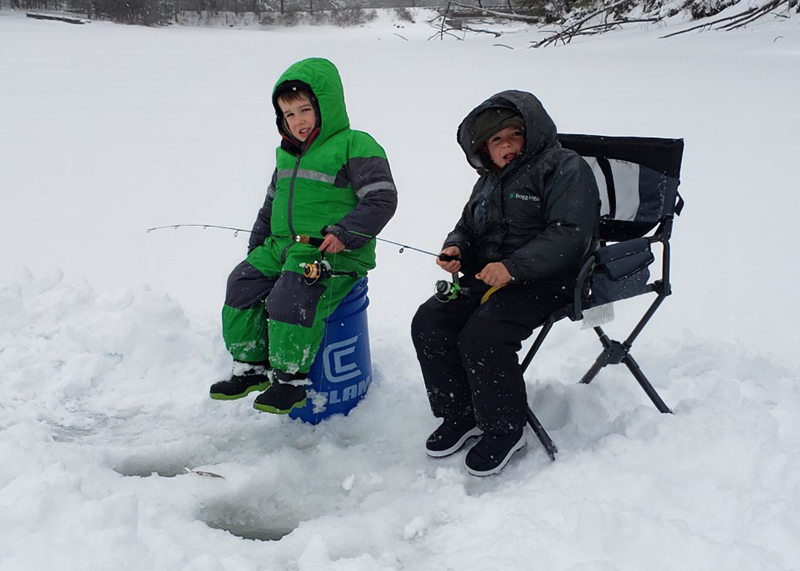Like they say on some obscure TV show no one’s ever seen: winter is coming. The good news is that in this neck of the woods that doesn't portend the end of fishing season, much less an invasion of malevolent blue-eyed ice creatures. Truth be told, in the Mid-Atlantic region fishing season never does end — it just changes, and there are plenty of winter fishing options. And for those new to fishing, these changes can make it challenging to get a bend in your rod. Never fear, beginner angler, we're here to help. Though your fingers may go numb and you might find yourself standing in blowing snow, remember these basics and you'll be fighting fish all winter long.

How to Fish During Winter
When it comes to winter fishing, the first thing you need to keep in mind is that preparing properly for the chilly conditions is job number one. Not only can it be dangerous to head outside in sub-freezing temperatures, if you're shivering uncontrollably or you lose all dexterity in your hands, you simply can’t fish because tasks like tying knots or baiting hooks become impossible. So, it's critical to dress properly. In addition to layering up and wearing a warm hat, a good pair of fingerless gloves is must-have winter fishing attire. You can't tie those knots nor bait those hooks with a pair of ski gloves covering them up. Everyone has their own favorite style, but most serious winter anglers like fleece gloves that have a flap you can leave off when using your hands and then fold over to cover your fingers when you don't need to use them. Waterproof versions are best.
TIP: Getting your hands wet can quickly ruin a trip so try hard to keep them dry and carry a small towel for drying your fingers off immediately, if they do get wet. When fishing with live bait like minnow, always use a small dip net or pull-out strainer bucket so you can minimize the moisture when baiting up.
Another item many anglers like to bring is a hand warmer. Having an artificially warm pocket you can shove your hand in for a few minutes works wonders. Some gloves will also have a slot designed to hold a hand warmer, though we must note that modern battery-operated hand warmers can quickly generate a lot more heat than the old shake-and-bake pouches.

If you'll be on a boat or watercraft, both the potential for trip-ending exposure and the danger-factor gets multiplied during the winter months. Check out Paddler’s Edge: Winter Kayak Safety to find detailed information on safety and gear for spending winter fishing time afloat on small watercraft.
As for the fishing itself, tempting the fish to bite isn't all that different from fishing at other times of the year with one big exception: since fish are cold-blooded, their metabolism slows down quite a bit during the winter months. As a result, everything happens a lot slower than it does during the summer. Bait and predators will both be swimming around at what appears to be a rather lazy pace. In most cases (there are a few exceptions) jigging rapidly or retrieving frantically is more likely to startle the predators than it is to get them biting. So you need to slow all motion down a notch. Rather than snapping the rod tip, just give it a little twitch. Rather than trolling at four or five mph, slow down to two or even less. You want your offering to appear lethargic, just as it would in nature when the water's chilly and cold. That said, you can't let a lure just sit there and expect it to be eaten. So don't stop retrieving or jigging entirely, just use mellow motions and gentle jiggles. Which brings us to...
Fishing Lures vs. Fishing Baits in Winter
Baits are more effective than lures in many situations, but this is never truer than during the winter months. In fact, most anglers — even those who may fish lures religiously through the warmer months of the year — will “resort” to using bait once the waters have grown icy-cold. Of course, there are exceptions. But as a general rule of thumb you'll do a lot better by using bait in one fashion or another.
That's not to say you should leave all the lures at home. In fact, many anglers favor using lures along with bait. If you're targeting bass, crappie, or pickerel, for example, bring plenty of marabou jigs or shad darts. But instead of tossing them out there bare, lip-hook a minnow for added attraction. The minnow will wiggle enticingly, adding a slow but irresistible temptation to your offering. Or if you’re after bluegill, perch, or trout, the slow-motion curling of a live wax worm or mealworm can trigger the strikes.
Choosing Hotspots for Winter Fishing
During the cold months of the year fish will move to different areas than you'll commonly find them when it’s warm out. As a general rule of thumb, it’s common to find fish holding in or near deeper than usual waters. Once surface temps drop to about 39 degrees (Fahrenheit! We live in ‘Merica!), the cool water becomes less dense, and begins floating over warmer water. Deeper waters also feature more temperature stability on a day-to-day basis. Of course, factors like current or a strong breeze that causes mixing will change things. But as a rule of thumb once winter hits you should expect the fish to move to deeper areas as compared to where you found them in the warmer months.
There are some specific exceptions anglers need to know about. One big one is late in the afternoon on sunny days. In this scenario the sun may warm up the south-facing bank of a lake or pond through the course of the day, and water temperatures can rise by a couple of degrees as that heat makes its way from the banks into the shallow waters close by. By the time late afternoon hits, fish may congregate in the warmer zone to catch a break from the chill — and if you know to look for them there, you'll be the one doing the catching.
What about choosing which water body of water to try, in the first place? Checking out the FishTalk fishing reports is step number-one. If you're not already getting weekly alerts, sign up for them and you'll get an email with a link to the reports every Friday by noon, when the new ones go up. And yes, we do keep them flowing all winter long!
Beyond that, remember that generally speaking in our region the best action will come from freshwater lakes and millponds, rivers, and relatively low-salinity areas of tidal tributaries. When and if ice starts forming you may be limited to areas with current that keeps the water open, or if it gets really cold out you might want to try your hand at ice fishing.

Most of the species that overlap freshwater and tidal waters, such as bass, pickerel, and perch, are known to bite well year-round. Species that live in flowing river waters like trout, smallmouth bass, and walleye are also a good bet. But in the Bay and along the coast many of the saltier bites shut down, as a good number of the gamefish species we enjoy pursuing in the summer months migrate away.
Exceptions? Striped bass may be found in a few select hotspots (but of course are out of season and at some times in some places are closed even to catch and release, so check the regs closely); some open waters can produce white perch; and you can catch tautog until water temperatures drop into the lower 40s in southern portions of the Bay. Running out into the ocean may be possible to find fish like tautog, sea bass (though it may not be legal to keep them, again the regulations need to be checked for current restrictions), and tilefish. Considering how difficult the weather can make things and how tough it can be to find good action, however, the majority of the anglers who fish year-round in the Mid-Atlantic region mostly look to freshwater and inland waterway options at this time of year.
One other species we need to note: whether you're talking about a freshwater impoundment or a tidal river, in many cases catfish will present an excellent winter fishing opportunity. These fish do feed all year long, and in some areas (like the Susquehanna near the 95 bridge, the Potomac in the D.C. area, or the upper James or Rappahannock Rivers) will provide nonstop action through a day of winter fishing. Check out Hot Action on Cool Cats to find out the details.
Tides and Timing for Winter Fishing
As during the summer months, tides can be a critical factor in tributary waters. Generally speaking falling or low tides will concentrate the fish in a smaller area and make it easier to find them. Often finding the channels and fishing around their edges is a solid move when the water's low. On high tides the fish do tend to scatter out a bit more and may be tougher to find, but that doesn't mean they won't be biting if you can locate them.
In freshwater impoundments tides obviously aren't a factor, but time of day certainly is. Expect mornings to be good but on a slightly delayed schedule as compared to summer fishing. Rather than peaking at sunrise, the best action will often come an hour or so later. Similarly, the period leading up to an hour before sunset is often better than last light. Weather patterns can modify this, however, as a very warm, sunny day may cause the fish to continue a late afternoon bite right up to dark.
Yes, it's true: winter is coming. But there are no White Walkers you’ll need to hide from around here, and winter most certainly does NOT mean that fishing is over for the season. So grab those gloves and a hat, fill a thermos with piping-hot coffee, and let a day of fishing help make cabin fever a thing of the past.